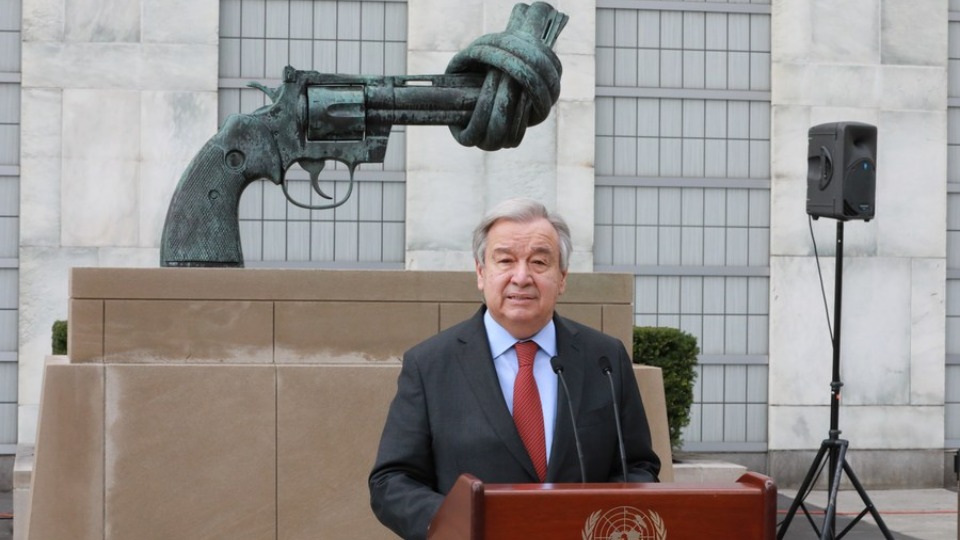
As United Nations Secretary-General António Guterres shuttled from New York to Moscow to Kiev hoping to broker a ceasefire in the Ukraine war last week, U.S. Defense Secretary Lloyd Austin convened a 40-nation armaments meeting in Germany to prepare for what U.S. military officials have said will be a “protracted conflict.”
In the Russian capital, Guterres met with President Vladimir Putin and Foreign Minister Sergei Lavrov and pushed them to continue negotiations for a diplomatic solution to the Ukrainian crisis.
“I came to Moscow as a messenger of peace,” Guterres said Tuesday. “My objective and my agenda are strictly linked to saving lives and reducing suffering.”

The U.N. chief called his discussions with Russian officials “very frank” and expressed concern about reports of violations of human rights law in the war. He pressed for agreement on further humanitarian corridors to allow civilian evacuations and food deliveries to besieged cities, such as the port of Mariupol.
Arriving in Kiev Wednesday, Guterres declared, “War is an absurdity in the 21st century; war is evil.” Surveying the destruction of the city, he said, “There is no way a war can be acceptable in the 21st century.”
His first meeting will be with Ukrainian Foreign Minister Dmytro Kuleba. President Volodymyr Zelensky is then expected to host Guterres for discussions, although Zelensky has criticized the U.N. head for meeting with Putin before him.
Preparing for permanent war?
While Guterres was on a ceasefire tour, U.S. military officials convened a meeting of dozens of countries at the Ramstein Air Base in Germany with the aim of arming Ukraine for a long war.
Ramstein is the headquarters of the U.S. Air Force for Europe and Africa and is also home to NATO Allied Air Command. For decades, it was the launch base for hundreds of U.S. nuclear weapons aimed at the Soviet Union, and later Russia.
The conference’s official goal was to assemble a standing body to coordinate the supply of arms and other defense aid to Ukraine. Statements by U.S. officials, however, suggest the group is also intended as a major component of the effort to “contain” Russia in ways that go beyond the current war.
The new “Ukraine Contact Group” will be run by the United States and include defense ministers and military chiefs from other nations. It is expected to meet monthly—signaling U.S. preparations for a long war. The U.S. Army newspaper Stars & Stripes said the establishment of the body signaled that U.S. involvement in the war was entering a “new phase.”

U.S. Defense Secretary Lloyd Austin hosted the conference, together with top U.S. General Mark Milley. Ahead of the meeting, Austin declared that the U.S. strategy in Ukraine is “to see Russia weakened” and ensure it does not have the “capability to reproduce” its military capacity.
The new weapons council, Austin said, would “strengthen Ukraine’s military for the long haul.” Milley, who is Chairman of the Joint Chiefs of Staff, earlier said that he views the war as a “protracted conflict” that will be “at least measured in years.”
NATO Secretary-General Jens Stoltenberg echoed Austin and Milley, saying, “There is absolutely the possibility that this war will drag on and last for months and years.”
Following the meeting, moves were quickly made in Washington and other NATO capitals to pump more weapons into the deadly conflict. President Joe Biden requested the U.S. Congress spend another $33 billion on arms and other aid for Ukraine, including $2.6 billion earmarked for dispatching U.S. troops and equipment to eastern Europe.
Biden said he wants the Ukraine spending tied to $22.5 billion in pandemic response aid at home in the U.S. Both Democrats and Republicans have been eager to approve previous weapons requests, but Biden’s COVID-19 help is likely to be sunk by the GOP.
In Berlin, the German parliament backed a request from Chancellor Olaf Scholz to send more heavy arms. The measure was opposed by members of the left-wing party Die Linke. Speaking to the media before the vote, Axel Ruppert, a researcher working for Die Linke’s Rosa Luxemberg Stiftung think tank, said, “Militarization does not guarantee peace…. This is the thing we can learn from history, and I’m afraid it will remain true this time.”
In London, Armed Forces Under-secretary James Heappey announced the U.K. will dispatch hundreds of supersonic anti-ship missiles within the next few weeks. Three days earlier, Heappey’s boss, Defense Secretary Ben Wallace, said that armored vehicles and anti-aircraft missiles are already on the way.
Canada said it was sending drone cameras and M777 vehicles and would also scour its defense inventory for more surplus.
What hope for peace?
Neither the U.S. military officials in Ramstein nor any of the NATO member countries’ leaders expressed any interest in or support for the efforts by Guterres to broker a ceasefire in Moscow and Kiev. Reports and opinion columns in many U.S. corporate press outlets actually dismissed the U.N.’s attempts, with one CBS headline declaring there was “little hope for peace.”

Washington Post columnist Jennifer Rubin wrote that Russia was “whin[ing] that this is a ‘proxy’ war, fanning Russian paranoia that the West is out to encircle and destroy Russia,” to which she responded, “Well, this certainly is a proxy war…to weaken Russia….” Rubin essentially acknowledged what U.S. officials have previously been reluctant to admit—that the war in Ukraine is not only aimed at repelling the Russian invasion but at bolstering long-term U.S. imperialist strategy against Russia, as well.
There were few signs that anyone in charge in Moscow or Kiev was eager to embrace Guterres’ peace moves, either. His effort was met with lukewarm reception, at best.
Russia’s first deputy permanent representative to the U.N., Dmitry Polyanskiy, answered that a ceasefire was not a “good option right now,” alleging it would allow time for Ukrainian forces to regroup. As he spoke, Russian troops continued pounding cities in the Donbas region, particularly Mariupol.
And Igor Zhovkva, the deputy head for Zelensky’s office, told NBC it was “not a good idea” for Guterres to meet with Putin and said peace talks with Russia would not “end up with any result.”
The U.N. leader was undeterred, however, saying, “It is my deep conviction that the sooner we end this war, the better for the people of Ukraine, for the people of Russia, and for those beyond.”
As with many news and analytical articles published by People’s World, any opinions reflected in this article are solely those of its authors.

MOST POPULAR TODAY

Zionist organizations leading campaign to stop ceasefire resolutions in D.C. area


High Court essentially bans demonstrations, freedom of assembly in Deep South

Afghanistan’s socialist years: The promising future killed off by U.S. imperialism

Communist Karol Cariola elected president of Chile’s legislature






Comments